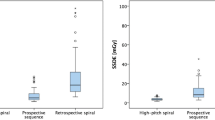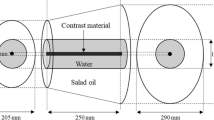Abstract
We explored whether dual-energy computed tomography (DECT) can allow a significant reduction in iodinated contrast volume during computed tomography angiography (CTA) without hampering image quality or assessibility. We prospectively randomized patients clinically referred to CTA to single energy computed tomography (SECT) with full iodine volume load (group A), DECT with 50 % iodine volume load (group B), DECT with 40 % iodine volume load (group C), and DECT with 30 % iodine volume load (group D); and compared image quality and assessibility. Eighty patients were enrolled and prospectively randomized. The mean age was 61.7 ± 15.0 years and 56 (71 %) patients were male. The demographical characteristics, body mass index, or mean radiation dose did not differ between groups. Significant reductions in total contrast volume were achieved in groups B, C, and D; with mean administrated contrast volumes of 90.3 ± 10.1, 39.5 ± 4.6, 28.3 ± 6.5, and 23.9 ± 6.0 mL, respectively, in groups A to D (p < 0.0001). With regard to image quality, no significant decrease in the Likert scale was observed with reductions of up to 60 % of the contrast volume (groups B and C). DECT at 50–60 keV in association with up to 60 % iodine load reduction, allowed similar signal density, image noise, and signal to noise ratio that SECT imaging with full iodine load. In this pilot, prospective, randomized study, dual energy CTA with up to 60 % iodine volume load reduction provided similar image quality and assessibility than full iodine load with conventional SECT imaging.


Similar content being viewed by others
References
Thomsen HS (2008) ESUR guidelines on contrast media, version 7.0. Heidelberg, Germany: European Society of Urogenital Radiology
Toprak O (2007) Conflicting and new risk factors for contrast-induced nephropathy. J Urol 178:2277–2283
Tepel M, Aspelin P, Lameire N (2006) Contrast-induced nephropathy: a clinical and evidence-based approach. Circulation 113:1799–1806
Laville M, Juillard L (2010) Contrast-induced acute kidney injury: how should at-risk patients be identified and managed? J Nephrol 23(04):387–398
de Agustín JA, Carda R, Manzano MC, Ruiz-Mateos B, García-Rubira JC, Fernández-Ortiz A, Vilacosta I, Macaya C (2007) Creatinine clearance and contrast nephropathy in patients with normal creatinine levels. Rev Esp Cardiol 60(7):772–776
So A, Lee TY, Imai Y et al (2011) Quantitative myocardial perfusion imaging using rapid kVp switch dual-energy CT: preliminary experience. J Cardiovasc Comput Tomogr 5(6):430–442
Yuan R, Shuman WP, Earls JP et al (2012) Reduced iodine load at CT pulmonary angiography with dual-energy monochromatic imaging: comparison with standard CT pulmonary angiography—a prospective randomized trial. Radiology 262(1):290–297
Boxt LM (2012) Coronary computed tomography angiography: a practical guide to performance and interpretation. Semin Roentgenol 47(3):204–219
Mitchell AM, Jones AE, Tumlin JA, Kline JA (2010) Incidence of contrast-induced nephropathy after contrast-enhanced computed tomography in the outpatient setting. Clin J Am Soc Nephrol 5:4–9
Kane GC, Doyle BJ, Lerman A, Barsness GW, Best PJ, Rihal CS (2008) Ultra-low contrast volumes reduce rates of contrast-induced nephropathy in patients with chronic kidney disease undergoing coronary angiography. J Am Coll Cardiol 51:89–90
Faggioni L, Neri E, Sbragia P, Pascale R, D’Errico L, Caramella D, Bartolozzi C (2012) 80-kV pulmonary CT angiography with 40 mL of iodinated contrast material in lean patients: comparison of vascular enhancement with iodixanol (320 mg I/mL) and iomeprol (400 mg I/mL). AJR Am J Roentgenol 199(6):1220–1225
Delesalle MA, Pontana F, Faivre JB, Flohr T, Tacelli N, Remy J, Remy-Jardin M (2013) Spectral optimization of chest CT angiography with reduced iodine load: experience in 80 patients evaluated with dual-source, dual-energy CT. Radiology 267(1):256–266
Nance JW Jr, Henzler T, Meyer M et al (2012) Optimization of contrast material delivery for dual-energy computed tomography angiography in patients with suspected pulmonary embolism. Invest Radiol 47(1):78–84
Manske CL, Sprafka JM, Strony JT, Wang Y (1990) Contrast nephropathy in azotemic diabetic patients undergoing coronary angiography. Am J Med 89:615–620
Baker ME, Dong F, Primak A, Obuchowski NA, Einstein D, Gandhi N, Herts BR, Purysko A, Remer E, Vachhani N (2012) Contrast-to-noise ratio and low-contrast object resolution on full- and low-dose MDCT: SAFIRE versus filtered back projection in a low-contrast object phantom and in the liver. AJR Am J Roentgenol 199(1):8–18
Conflict of interest
We declare that Drs. Patricia Carrascosa and Jonathon Leipsic are Consultants of GE. There are no competing interests related to the manuscript for any of the other authors.
Author information
Authors and Affiliations
Corresponding author
Rights and permissions
About this article
Cite this article
Carrascosa, P., Capunay, C., Rodriguez-Granillo, G.A. et al. Substantial iodine volume load reduction in CT angiography with dual-energy imaging: insights from a pilot randomized study. Int J Cardiovasc Imaging 30, 1613–1620 (2014). https://doi.org/10.1007/s10554-014-0501-1
Received:
Accepted:
Published:
Issue Date:
DOI: https://doi.org/10.1007/s10554-014-0501-1




